Journal of Nutrition & Food Sciences
Open Access
ISSN: 2155-9600
ISSN: 2155-9600
Research Article - (2021)Volume 11, Issue 2
Background: It has been reported that chocolates and almonds have a wide variety of health benefits. Chocolatecovered almonds (almond chocolates) are popular chocolate confectioneries in Japan. However, their health benefits have not yet been explored to date. To clarify their health benefits, we investigated the beneficial effects of the intake of almond chocolates on bowel movement and skin conditions. Methods: This single-blinded (investigator-blinded) parallel-group comparison study was conducted on women with a tendency toward constipation and subjective symptoms of dry skin. The study included 36 participants who consumed eight pieces (approximately 30 g) of almond chocolates daily in the treatment (intake) group and 35 participants in the control (no intake) group. Bowel movement and skin conditions of these individuals were evaluated based on the records in their diaries and the stratum corneum water content measured before intervention (baseline values) and 4 and 8 weeks after intervention, respectively. In addition, questionnaire surveys about subjective symptoms were administered and an evaluation was conducted based on the obtained responses. Results: The results showed that the intake of almond chocolates significantly improved the respondents’ (participants’) bowel movements (i.e., stool frequency and amount), and the surveys showed improvement in their gastrointestinal and skin conditions. In addition, stratified analysis of individuals with severely dry skin symptoms revealed that intake of almond chocolates significantly improved the stratum corneum water content 8 weeks after the intervention compared with baseline levels (before intervention).
Almond; Chocolate; Bowel movement; Skin conditions
It has been reported that chocolates and almonds have a wide variety of health benefits [1-5]. Although chocolatecovered almonds (almond chocolates) are popular chocolate confectioneries in Japan, to date, their health benefits have not been explored in detail.
Several studies have reported the beneficial effects of chocolate ingredients or almonds on intestinal flora; hence, it is expected that almond chocolates have beneficial effects on bowel movement and intestinal flora [6-8]. It is known that constipation is a contributory factor to the decline in quality of life (QOL), and improvement of constipation is a worthwhile participant of study in Japan, where many people have subjective symptoms of constipation [9]. In addition, it has been widely known that exhibiting continuing symptoms of constipation is likely to worsen skin conditions. Against this background, several studies have reported that improving the intestinal environment may remedy skin conditions, suggesting that the intake of almond chocolates could exert beneficial effects on skin conditions [10- 12].
Thus, we conducted a single-blinded, parallel-group comparison study to verify the beneficial effects of the intake of almond chocolates on bowel movement and skin conditions.
Study design
This randomized, single-blinded, parallel-group comparison study was conducted according to the principles stipulated in the Declaration of Helsinki. Written informed consent was obtained from all participants prior to their participation in the study, which was conducted from February to April 2017. This study was approved by the Institutional Review Board of Shinkokai and the Meiji Institutional Review Board (UMIN000025966).
Participants
Eighty-three healthy Japanese volunteers were screened according to the inclusion and exclusion criteria described below. The inclusion criteria were as follows: (1) women who voluntarily consented to participate in the study; (2) those that were 25-50 years old; (3) those whose stool frequency in 2 weeks immediately before screening was 2-4 times/week; and (4) those who had subjective symptoms of dry skin at screening. The exclusion criteria were as follows(1) those who were undergoing treatment for any chronic disease; (2) those who had severe symptoms of pollen allergy; (3) those whose skin conditions at the site to be tested were prominently abnormal; (4) those who were allergic to foods such as cacao, almond, milk, wheat, egg, and soybean; (5) those who commonly consumed a large amount of cacao products and nuts; (6) those who commonly took medicines and/or supplements that could affect the results of this study during the period from 3 months before screening to the end of the study; (7) those who were receiving specific facial care (such as facial massager, aesthetic treatment, peeling treatment, and laser treatment); (8) those who participated in any other study within 1 month before screening; (9) those who were pregnant or had plans to conceive during the study period; (10) those who were lactating; and (11) those who were considered by an investigator to be ineligible for the participant of the study.
Protocol
This single-blinded (investigator-blinded), parallel-group comparison study involved an almond chocolate intake group (the intake group) and a non-intake group (the control group). The participants were randomly allocated to either group so that the factors of age, stool frequency, and stratum corneum water content at screening might be equivalent.
Participants in the intake group consumed eight pieces of almond chocolates (approximately 30 g) every day for 8 weeks, whereas those in the control group did not. Table 1 shows the nutritional composition analytical values of the almond chocolates (Almond Chocolate Cacao 70%; Meiji Co. Ltd., Tokyo, Japan) used in the study.
| - | Per eight almond chocolates/day |
|---|---|
| Energy (kcal) | 178 |
| Protein (g) | 5 |
| Lipid (g) | 13.6 |
| Carbohydrate (g) | 7.1 |
| Dietary fiber (g) | 3.8 |
| Water soluble (g) | 0.5 |
| Water insoluble (g) | 3.3 |
| Sodium (mg) | 5.8 |
| Vitamin E (a-tocopherol) (mg) | 2.9 |
| Cacao polyphenol (mg) | 395 |
Table 1: Nutritional composition analytical values of almond chocolates.
The participants recorded their defecation activities (stool frequency and amount) in their diaries every day during the period from 2 weeks before the intervention to 8 weeks after intervention. The stool amount was converted to the number of eggs for recording.
The stratum corneum water content of the skin in the cheeks of the participants was measured before the intervention and 4 and 8 weeks after intervention. To ensure that the measurement conditions were even, the participants were asked to wash their faces in a specific manner and condition their skin in a constant temperature and humidity room (room temperature, 20 ± 2°C; humidity, 50 ± 5%) for more than 20 minutes. Then, the stratum corneum water content was measured using Corneometer® CM825 (Courage-Khazaka Electronic, Cologne, Germany).
The questionnaire surveys about the gastrointestinal and skin conditions were administered to the participants before the intervention and 4 and 8 weeks after intervention. Visual Analog Scale (VAS) was used in the questionnaire survey, and the participants were asked to record the feeling levels of symptoms on the 100-mm line with the leftmost end (0 mm) indicating “very bad” and the rightmost end (100 mm) indicating “very good.”
Outcomes
The outcomes were “stool frequency,” “stool amount,” “stratum corneum water content,” and “gastrointestinal and skin conditions based on the responses to the surveys.” Stool frequency and amount were evaluated on the basis of the total value calculated every week during the study period. However, each of the baseline values of stool frequency and amount was calculated by dividing the total values measured 2 weeks before intervention by 2. Stratum corneum water content and the outcomes based on the responses to the questionnaires were evaluated on the basis of values measured on test points (before intervention and 4 and 8 weeks after intervention).
Statistical analysis
In statistical analysis of baseline characteristics of the participants, a group comparison of stool frequency was performed using Mann-Whitney’s U-test and a group comparison of age and stratum corneum water content was performed using unpaired t-test. In statistical analysis of stool frequency and amount, intragroup comparison at the given time points before and after intervention was made using Wilcoxon signed-rank test and group comparison of the amount of change and the change rate at the given time points before and after intervention was made using Mann-Whitney’s U-test. In statistical analysis of age, stratum corneum water content, and subjective symptoms (VAS) in the questionnaires, intragroup comparison at the given points before and after intervention was performed using one-sample t-test and group comparison of the change at the given time points before and after intervention was made using unpaired t-test. The level of significance was defined as 5% on both sides. SPSS statistics 24 (IBM Corp., Armonk, NY, USA) was used for statistical analyses.
Participants
Out of 142 candidates initially considered for participation in this study, 83 were screened according to the inclusion and exclusion criteria. The participants were randomly allocated to either the intake group (n=42) or the control group (n=41). Further, except for dropouts and those who violated the protocol, 71 participants were analyzed. Figure 1 illustrates the procedural flow of how participants were enrolled in the study, from the recruitment stage to analysis, and Table 2 shows the baseline characteristics of participants. No significant differences in age, stool frequency, and stratum corneum water content were observed at baseline between the intake and control groups.
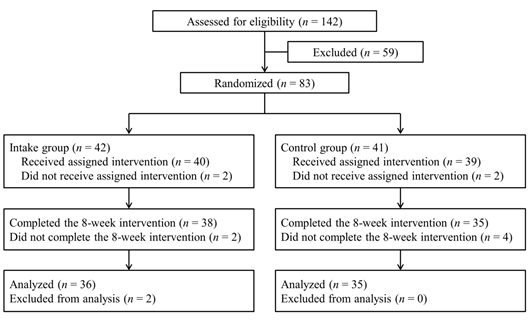
Figure 1. Procedural flow of study participants.
| - | Intake group | Control group | p |
|---|---|---|---|
| Number of participants | 36 | 35 | - |
| Age (years) | 41.5 ± 6.7 | 42.8 ± 5.3 | 0.349 |
| Stool frequency (times/week) | 3.8 ± 1.5 | 4.0 ± 1.4 | 0.55 |
| Stratum corneum water content (AU) | 46.40 ± 9.37 | 46.63 ± 9.09 | 0.918 |
| Note: Values are presented as mean ± standard deviation | |||
Table 2: Baseline characteristics of participants.
Beneficial effects of almond chocolates on stool frequency and amount
A change in stool frequency is shown in Table 3, and a transient change is shown in Figure 2. The stool frequency (times/week) significantly increased throughout the period from 1 to 8 weeks after intervention compared with baseline level (before intervention) in the intake group, whereas a significant decrease was observed only at week 1 after intervention in the control group. The result of the group comparison of the change in stool frequency demonstrated that a significant difference was observed throughout the period from weeks 1 to 8 after intervention, suggesting that the intake of almond chocolates improved stool frequency.
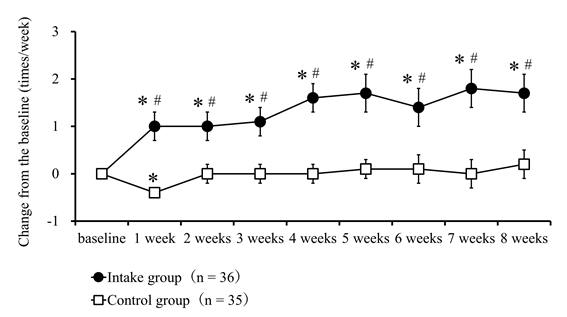
Figure 2. Change in stool frequency (times/week) from baseline. Intake of almond chocolates increased the stool frequency. Values are presented as mean ± standard deviation. Before-andafter- intervention comparison: *p<0.05. Comparison with the control group: #p<0.05.
| - | Intake group (n=36) | Control group (n=35) | ||||
|---|---|---|---|---|---|---|
| Mean ± SE | pa | Mean ± SE | pa | pb | ||
| Stool frequency (times/week) |
Baseline | 3.8 ± 0.2 | - | 4.0 ± 0.2 | - | - |
| 1 week | 4.8 ± 0.3 | 0.001 | 3.7 ± 0.2 | 0.021 | 0.000 | |
| 2 weeks | 4.9 ± 0.4 | 0.000 | 4.1 ± 0.2 | 0.680 | 0.005 | |
| 3 weeks | 4.9 ± 0.4 | 0.003 | 4.1 ± 0.2 | 0.625 | 0.045 | |
| 4 weeks | 5.4 ± 0.4 | 0.000 | 4.1 ± 0.3 | 0.662 | 0.000 | |
| 5 weeks | 5.6 ± 0.5 | 0.000 | 4.1 ± 0.3 | 0.596 | 0.001 | |
| 6 weeks | 5.3 ± 0.5 | 0.000 | 4.1 ± 0.3 | 0.689 | 0.005 | |
| 7 weeks | 5.7 ± 0.5 | 0.000 | 4.0 ± 0.2 | 0.865 | 0.001 | |
| 8 weeks | 5.5 ± 0.5 | 0.000 | 4.3 ± 0.3 | 0.747 | 0.004 | |
| Stool amount (converted to number of eggs/week) | Baseline | 6.6 ± 0.6 | - | 8.6 ± 0.6 | - | - |
| 1 week | 8.5 ± 0.8 | 0.001 | 8.5 ± 0.7 | 0.776 | 0.001 | |
| 2 weeks | 8.8 ± 0.8 | 0.001 | 9.3 ± 0.7 | 0.205 | 0.016 | |
| 3 weeks | 8.7 ± 0.8 | 0.006 | 9.2 ± 0.6 | 0.158 | 0.062 | |
| 4 weeks | 10.2 ± 1.0 | 0.000 | 8.8 ± 0.7 | 0.798 | 0.000 | |
| 5 weeks | 9.9 ± 1.0 | 0.000 | 9.3 ± 0.8 | 0.185 | 0.002 | |
| 6 weeks | 10.5 ± 1.2 | 0.000 | 9.1 ± 0.8 | 0.238 | 0.001 | |
| 7 weeks | 10.9 ± 1.2 | 0.000 | 9.0 ± 0.8 | 0.447 | 0.000 | |
| 8 weeks | 10.8 ± 1.2 | 0.000 | 10.5 ± 1.3 | 0.052 | 0.006 | |
| Note: a Before-and-after-intervention intracomparison at the given time points. b Group comparison of change before and after intervention at the given time points. |
||||||
Table 3: Changes in stool frequency and amount.
A change in stool amount converted to the number of eggs is shown in Table 3, and a transition in the change rate of stool amount, assuming the baseline stool amount as 1 is shown in Figure 3. The stool amount significantly increased throughout the period from weeks 1 to 8 after intervention compared with the baseline level in the intake group, whereas no significant change was observed in the control group. The result of group comparison of the change rate showed that significant differences were detected during all weeks since week 1 after intervention except during week 3, suggesting that the intake of almond chocolates might have increased the stool amount.
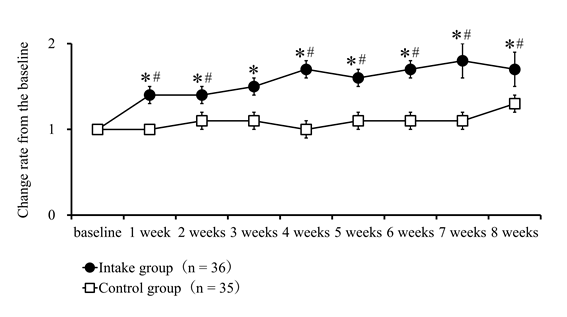
Figure 3. Change rate of stool amount/week, assuming the baseline value as 1. Intake of almond chocolates increased the stool amount. Values are presented as mean ± standard deviation. Before-and-after-intervention comparison: *p<0.05. Comparison with the control group: #p<0.05.
Beneficial effects of almond chocolates on stratum corneum water content
The measured values of stratum corneum water content are shown in Table 4, and a transition in a change of the stratum corneum water content is shown in Figure 4. The results of the before-and-after comparison and the group comparison showed no significant differences in stratum corneum water content. Accordingly, we performed stratified analysis involving 46 participants with baseline stratum corneum water content of ≤ 50 AU who were regarded as those with severely dry skin conditions. The facial stratum corneum water content values as measured by a corneometer were classified into the following categories: “super dry skin,” ≤ 50 AU; “dry skin,” between 50 and 60 AU; and “hydrated skin,” ≥ 60 AU [13]. Further, participants with baseline stratum corneum water content of ≤ 50 AU demonstrated no significant difference in baseline characteristics between the intake (n=25) and control (n=21) groups (data not shown). A change in the stratum corneum water content in participants with severely dry skin conditions is shown in Figure 5. No significant difference in change amount from the baseline was observed between the intake and control groups. Although the result of a before-and-after-intervention comparison revealed no significant variation in the control group, a significantly high value was observed 8 weeks after the intervention compared with baseline level in the intake group, suggesting that their symptoms improved.
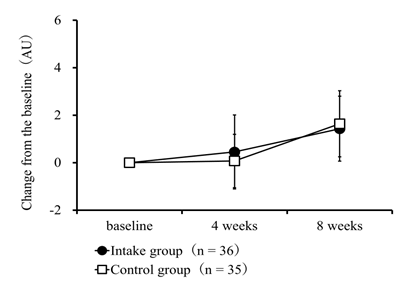
Figure 4. Change in stratum corneum water content from baseline. A significant change in stratum corneum water content was not observed in the participants in both the intake and control groups. Values are presented as mean ± standard deviation.
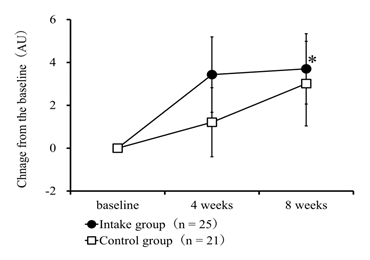
Figure 5. Change in stratum corneum water content from baseline among participants with severely dry skin conditions. Intake of almond chocolates increased the stratum corneum water content compared with that before intervention. Values are presented as mean ± standard deviation. Before-and-afterintervention comparison: *p<0.05.
| - | Intake group (n=36) | Control group (n=35) | ||||
|---|---|---|---|---|---|---|
| Mean ± SE | pa | Mean ± SE | pa | pb | ||
| Stratum corneum water content (AU) | Baseline | 46.40 ± 1.56 | - | 46.63 ± 1.54 | - | - |
| 4 weeks | 46.86 ± 1.36 | 0.773 | 46.70 ± 1.66 | 0.947 | 0.845 | |
| 8 weeks | 47.83 ± 1.33 | 0.305 | 48.27 ± 1.75 | 0.246 | 0.913 | |
| Note: a Before-and-after-intervention intracomparison at the given time points. b Group comparison of change before and after intervention at the given time points. |
||||||
Table 4: Change in stratum corneum water content.
Beneficial effects of almond chocolates on subjective symptoms
Results of the survey regarding the subjective symptoms of gastrointestinal and skin conditions using VAS are shown in Table 5. The VAS values of the subjective symptoms of the stomach and intestine increased with time only in the intake group, and significant differences were observed in the group comparison and intragroup comparison conducted 4 and 8 weeks after intervention, suggesting that the subjective symptoms of the stomach and intestine improved. The VAS values of the subjective symptoms of skin conditions increased with time in the intake group, and significant differences were observed in the group comparison and intragroup comparison conducted 4 and 8 weeks after intervention, suggesting that the subjective symptoms of skin conditions improved.
| - | Intake group (n=36) | Control group (n=35) | ||||
|---|---|---|---|---|---|---|
| Mean ± SE | pa | Mean ± SE | pa | pb | ||
| VAS values of gastrointestinal conditions (mm) | Baseline | 56.9 ± 3.0 | - | 53.5 ± 3.4 | - | - |
| 4 weeks | 66.1 ± 3.0 | 0.003 | 49.5 ± 3.0 | 0.187 | 0.002 | |
| 8 weeks | 68.4 ± 3.1 | 0.000 | 50.9 ± 2.8 | 0.442 | 0.023 | |
| VAS values of skin conditions (mm) | Baseline | 50.1 ± 2.5 | - | 50.1 ± 3.3 | - | - |
| 4 weeks | 56.8 ± 2.7 | 0.034 | 46.5 ± 3.2 | 0.271 | 0.002 | |
| 8 weeks | 62.2 ± 2.7 | 0.000 | 51.4 ± 2.7 | 0.620 | 0.006 | |
| Note: a Before-and-after-intervention intracomparison at the given time points. b Group comparison of change from before intervention to after intervention at the given time points. |
||||||
Table 5: Changes in subjective symptoms (VAS values).
In the present study, an 8-week single-blinded, parallel-group comparison study was conducted to verify the beneficial effects of almond chocolates on constipation and skin conditions, in which participants were divided into the intake and control groups. Analysis of 71 participants revealed that bowel movement (stool frequency and amount) improved in the intake group. According to the participants’ responses to the questionnaires about subjective symptoms of the gastrointestinal and skin conditions, these symptoms significantly improved in the intake group. However, no significant improvement in stratum corneum water content, an indicator for skin conditions, which was associated with the intake of almond chocolates, was observed. In contrast, stratified analysis, which was conducted on participants with severely dry skin conditions (determined according to the baseline values of cheek stratum corneum water content), showed that there was a significant increase in stratum corneum water content in the intake group 8 weeks after intervention. Thus, the intake of almond chocolates might improve the bowel movement of individuals with a tendency toward constipation and increase the stratum corneum water content in people with severely dry skin, resulting in improved skin conditions.
It is known that intake of food fibers is effective in improving constipation [14]. In this study, participants (intake group) were asked to consume eight pieces of almond chocolates per day, which contained 3.8 g of food fiber. The study suggests that the intake of food fiber contained in almond chocolates improved constipation. On the other hand, the intestinal flora was not investigated in the present study and it is unknown whether or not there were changes in the flora. However, on the basis of previous reports, it may be considered that the flora might change; therefore, change in the intestinal flora is a research issue to be tackled in the future [6-8].
In contrast, although bowel movement improved, no evident change was observed in the stratum corneum water content. To remedy skin conditions via the improvement of bowel movement, it may take some time before the beneficial effects can be observed because such stages as a change in the intestinal flora and a reduction of waste product in the blood are involved [10-12]. In addition, considering the epidermis requires about 4-6 weeks to reproduce, the time points used in this study might have been too short for the stratum corneum water content to change, even at the time point of 8 weeks. However, it should be noted that stratum corneum water content increased in participants with severely dry skin conditions; accordingly, a further study focusing on whether the skin conditions may be improved is required in the future.
An improvement was observed in the subjective symptoms of gastrointestinal and skin conditions, suggesting that participants might have experienced the above-mentioned beneficial effects. However, because participants in the control group did not consume almond chocolates, the improved subjective symptoms may have been affected by the action of the intake itself.
A single-blinded (investigator-blinded), parallel-group comparison study was conducted on women with a tendency toward constipation and subjective symptoms of dry skin to verify the beneficial effects of almond chocolates on the improvement of intestinal environment and skin conditions. The participants were randomly allocated either to the intake group or the control group. During the study period, participants in the intake group were asked to consume eight pieces (approximately 30 g) of almond chocolates every day.
The results showed that stool frequency and amount significantly increased in the intake group compared with those in the control group and subjective symptoms of the stomach and intestine also significantly improved in the former group. In addition, in the intake group, the subjective symptoms of skin conditions significantly improved and stratified analysis of participants with severely dry skin conditions demonstrated that the stratum corneum water content significantly increased 8 weeks after intervention.
Based on these findings, it is suggested that the continuous intake of almond chocolates improves bowel movement and skin conditions.
We express our deepest appreciation to CEO Masahiro Kuramochi, Dr. Maiko Tajima, Ms. Ai Marume, all of whom are working at Beauty and Health Research Inc.; and Dr. Toshitatsu Nogita, who is the director of Shinjuku Minamiguchi Dermatological Clinic of Shinkoukai and professor at the Dermatology Department of Tokyo Medical University, for their contribution to the present study.
This study was financially supported by Meiji Co., Ltd.
Yukari Kato, Midori Natsume, Kyoko Ito, Aiko Nakano, Kosuke Ozawa, Masayuki Sato, and Taketo Yamaji are employees of Meiji Co., Ltd. Hiroyoshi Inoue received a medical advisory fee from Meiji Co., Ltd.
Citation: Kato Y, Natsume M, Ito K, Nakano A, Ozawa K, Sato M, et al. (2021) Beneficial Effects of the Intake of Chocolate-covered Almonds on Bowel Movement and Skin Conditions. J Nutr Food Sci. 11:788.
Received: 28-Jan-2021 Accepted: 11-Feb-2021 Published: 18-Feb-2021 , DOI: 10.35248/2155-9600.21.11.1000788
Copyright: © 2021 Kato Y, et al. This is an open-access article distributed under the terms of the Creative Commons Attribution License, which permits unrestricted use, distribution, and reproduction in any medium, provided the original author and source are credited.
Sources of funding : This study was financially supported by Meiji Co., Ltd.